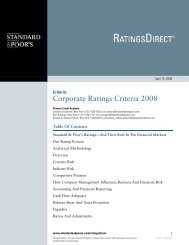European Infrastructure Finance Yearbook - Investing In Bonds ...
European Infrastructure Finance Yearbook - Investing In Bonds ...
European Infrastructure Finance Yearbook - Investing In Bonds ...
Create successful ePaper yourself
Turn your PDF publications into a flip-book with our unique Google optimized e-Paper software.
TRANSPORTATION INFRASTRUCTURE<br />
78 ■ NOVEMBER 2007<br />
the previous year, announced that it will increase<br />
the number of weekday trains it runs between<br />
Paris and London in February 2008, to 17 from<br />
15. This is positive for Eurotunnel.<br />
Rail freight.<br />
Stability of freight revenues in the short-tomedium<br />
term is a best-case scenario, while a<br />
further reduction is a more likely outcome.<br />
Future revenues are uncertain after the end of<br />
the subsidy to EWS in 2006, while the service has<br />
relied on state subsidy since services commenced<br />
in 1996. Also, the impact of the purchase of EWS<br />
by Deutsche Bahn AG (AA/Negative/A-1+) from<br />
BRB remains to be seen.<br />
Eurotunnel considers a possible upside,<br />
however. Eurotunnel intends to revive use of the<br />
tunnel by revising the fee structure for rail freight,<br />
making it cheaper for freight trains to run at<br />
night, while charging more at the busiest periods<br />
such as Friday evenings and Monday mornings.<br />
The move could be related to Eurotunnel’s<br />
intention to directly operate some cross-channel<br />
rail freight services (it has an operating license<br />
with its Europorte2 subsidiary). The group has<br />
purchased locomotives in the first half of 2007<br />
and has also ordered some additional locomotives<br />
to Bombardier to be used in the development of<br />
its rail freight activity.<br />
Rail freight services have tended to fare less<br />
well than other Eurotunnel markets. Perhaps the<br />
most important episode was the severe disruption<br />
associated with asylum seekers using trains to<br />
attempt to travel to the U.K. in 2001. This has led<br />
to freight users pulling out in favor of other<br />
transport alternatives, and the market has never<br />
really recovered.<br />
The volume of goods transported by freight<br />
trains declined by 1% compared with 2005, to<br />
1.57 million tons, after a 16% decline in 2005. <strong>In</strong><br />
1998, 3 million tons of freight moved through the<br />
tunnel, which is designed to carry a maximum of<br />
10 million tons. <strong>In</strong> the first half of 2007, traffic<br />
volumes were 14% down on the previous<br />
comparable period.<br />
Competition<br />
Eurotunnel is the operator of an essential<br />
infrastructure, but its revenue streams are not as<br />
predictable as for toll road network, airport, or<br />
port operators, which benefit from the<br />
STANDARD & POOR’S EUROPEAN INFRASTRUCTURE FINANCE YEARBOOK<br />
monopolistic nature of their industries.<br />
The future strategy of competitors (such as<br />
ferry companies and airlines) remains difficult to<br />
predict, meaning GDP or market growth does not<br />
always materialize in volume or revenue growth.<br />
Since 1996 (1997 for Eurostar services), truck and<br />
rail passenger volumes have increased, whereas<br />
car, coach, and rail freight volumes have tended<br />
to fall.<br />
The primary competition risks in the passenger<br />
market are low-cost and flag airlines and, to a<br />
lesser extent, ferry operators. The shuttle service<br />
enjoys a competitive advantage in terms of speed,<br />
frequency of departures, and reliability, which is<br />
reflected in its premium pricing. A significant<br />
competition risk stems from the ferry operators<br />
P&O, SeaFrance, Norfolkline, and SpeedFerries.<br />
Standard & Poor’s considers the impact on<br />
Eurotunnel’s truck shuttle revenues to be limited<br />
as a result of the successful segmentation strategy;<br />
the expected impact on car and coach shuttle<br />
revenues could be higher, and was factored in the<br />
base case. Eurotunnel estimates that its share of<br />
the accompanied truck market on the short straits<br />
corridor decreased to 36.2% in 2006 from 39.5%<br />
in 2005, reflecting its new strategy.<br />
Finally, freight trains compete directly with<br />
road transport and maritime transport on<br />
container ships. <strong>In</strong>tense competition in the crosschannel<br />
freight market between road haulage<br />
companies has recently put downward pressure<br />
on freight rates, making it more difficult for the<br />
railways to compete. The goods transported by<br />
freight trains are mainly heavy, lower-yielding<br />
items for which speed of delivery is not generally<br />
a primary consideration.<br />
Capital expenditure and maintenance<br />
Scheduled weekly maintenance of the tunnel is<br />
organized and structured to minimize disruption<br />
to commercial operations and optimize capacity<br />
during peak periods.<br />
The second cycle of rail replacement began in<br />
2005, and will continue until 2008 without<br />
disrupting commercial services. Under current<br />
rolling stock maintenance programs, essential<br />
maintenance and safety inspections are carried<br />
out on average every 21 days for the locomotives,<br />
freight shuttles, and passenger shuttles. The largescale<br />
maintenance program that began in 2003 is<br />
accelerating considerably in 2007, to restore and



